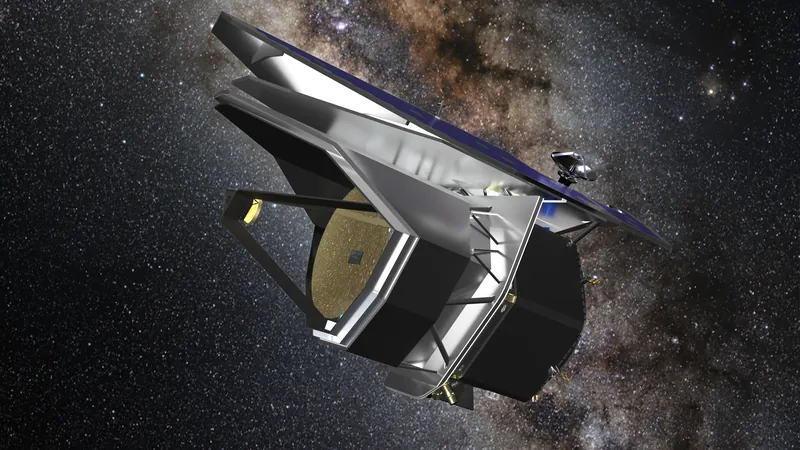
Unlocking Cosmic Mysteries: NASA’s Revolutionary PRIMA Probe on the Horizon
2024-10-23
Author: Wei
Unlocking Cosmic Mysteries: NASA’s Revolutionary PRIMA Probe on the Horizon
In an exciting development for space exploration, NASA is taking a bold step forward by introducing a new category of missions designed to bridge the gap between flagship projects like the James Webb and Hubble Space Telescopes and smaller-scale endeavors. This new initiative, known as the Probe Explorers program, has selected two innovative probe designs, each receiving $5 million in funding over the next year. Ultimately, one of these design concepts will compete for a substantial $1 billion funding opportunity aimed at getting the probe off the ground by 2032.
One of the standout candidates is PRIMA (PRobe far-Infrared Mission for Astrophysics), spearheaded by an international team that includes UConn’s own physics associate professor Cara Battersby. Battersby leads a crucial component of the project focused on uncovering the universe's hidden secrets.
A New Lens into the Far-Infrared Universe
PRIMA’s mission is significant because it aims to use far-infrared sensing technology to explore a vast swath of uncharted astronomical territory. This far-infrared range is a critical gap in our understanding of the cosmos, as existing telescopes, such as the James Webb, only cover the mid-infrared spectrum, while the Atacama Large Millimeter/submillimeter Array (ALMA) focuses on the submillimeter range.
According to Battersby, this specific wavelength is particularly elusive: “The Earth’s atmosphere absorbs far-infrared light from distant galaxies and forming planets. No telescope currently exists that can study this wavelength, so the potential of NASA backing this mission is exhilarating.”
Successful launch of PRIMA would allow scientists to investigate key cosmic epochs — namely, the “cosmic dawn,” when the first galaxies began to form, and “cosmic noon,” marking the peak of star formation. This mission promises to deliver vital data on the formation of planets and their atmospheres, enriching our understanding of how galaxies evolve over the eons.
Reconstructing the Cosmic Story
To draw an analogy, Battersby compares the current astrophysical landscape to trying to ascertain the ages of people in a crowd without knowing anything about human age progression. By understanding the characteristics of various ages, such as height and development, one could make educated guesses about their ages. Similarly, PRIMA will help astronomers distinguish between younger and older galaxies, knitting together the timeline of cosmic evolution.
Battersby articulately summarizes the challenge: “We see these pictures of galaxy populations, yet we lack insight into their origins and the forces that dictate their development. Key questions arise: What limits a galaxy’s size or star formation capabilities, and how does this relate to black hole formation?”
The quest for answers hinges on studying galaxies in their formative years and tracking their growth through the universe's timeline.
Empowering the Next Generation of Astronomers
Moreover, PRIMA has the potential to invigorate the broader astronomy community and offer UConn students remarkable research opportunities. Battersby highlights the excitement within the academic community: “A significant portion of the observatory time will be dedicated to the astronomy community, allowing them to propose their own research projects with PRIMA. We already received interest from about 70 researchers eager to leverage this mission.”
Should PRIMA be selected for launch, UConn students stand to gain unparalleled experience in a groundbreaking project. Graduate student Rachel Lee is already on the verge of publication with research that investigates potential applications for this mission.
Battersby concludes with enthusiasm: “The possibilities for students are incredible. Being part of this team not only enriches their academic careers but also allows them to contribute meaningfully to a project that has a very real chance of reaching the stars.”
As the competition heats up for funding and planning, the PRIMA mission stands poised to open new frontiers in our understanding of the universe and our origins within it. Keep an eye on the stars; the future of cosmic exploration is bright!

 Brasil (PT)
Brasil (PT)
 Canada (EN)
Canada (EN)
 Chile (ES)
Chile (ES)
 España (ES)
España (ES)
 France (FR)
France (FR)
 Hong Kong (EN)
Hong Kong (EN)
 Italia (IT)
Italia (IT)
 日本 (JA)
日本 (JA)
 Magyarország (HU)
Magyarország (HU)
 Norge (NO)
Norge (NO)
 Polska (PL)
Polska (PL)
 Schweiz (DE)
Schweiz (DE)
 Singapore (EN)
Singapore (EN)
 Sverige (SV)
Sverige (SV)
 Suomi (FI)
Suomi (FI)
 Türkiye (TR)
Türkiye (TR)